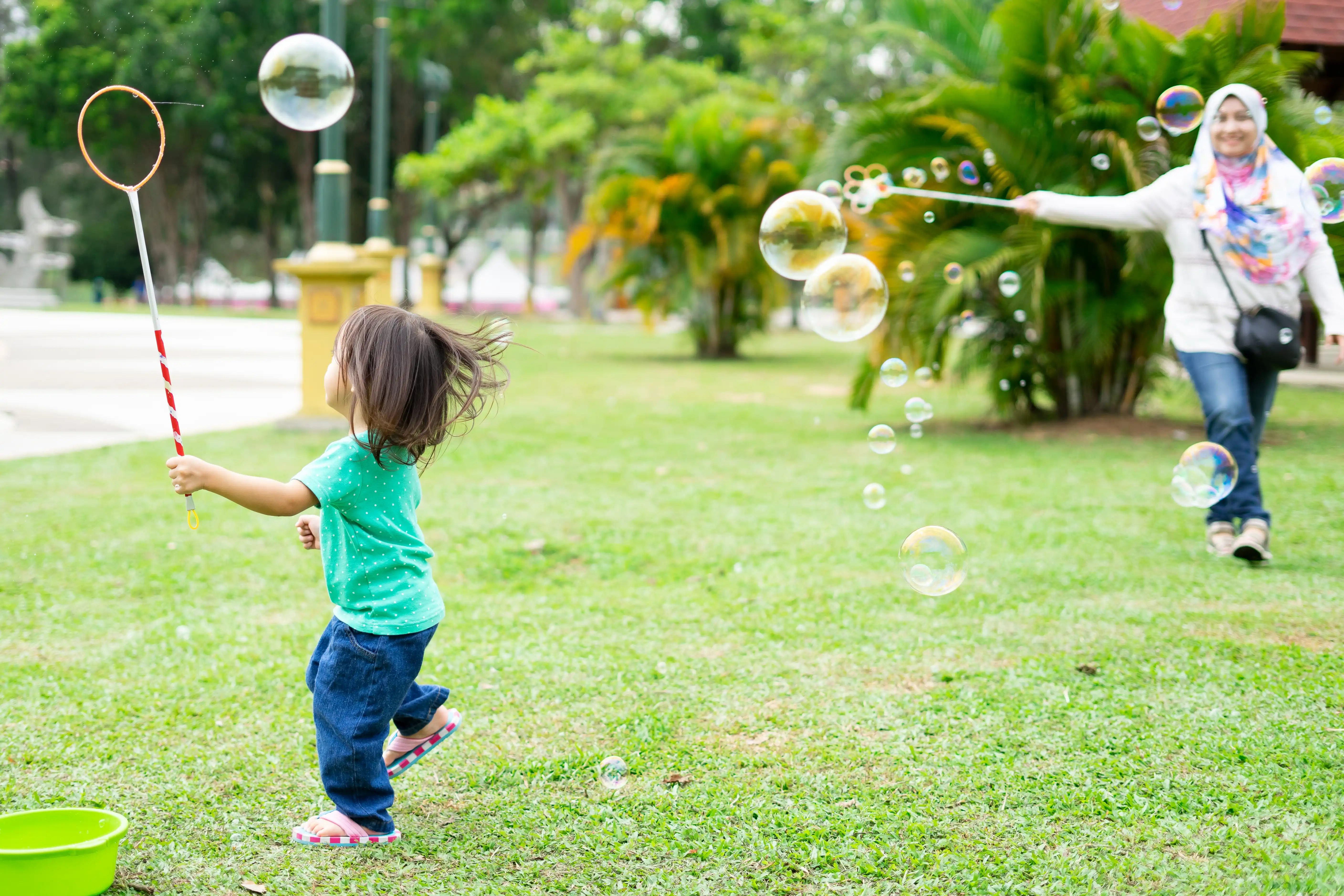Outdoor Games for Kids: Play, Move, and Learn Outside
Outdoor games give kids space to move, explore, and play together. This guide shares easy game ideas that support physical skills, teamwork, and outdoor confidence, with options for different ages and spaces.
Table of contents

Outdoor games for kids to stay active and social
Kids and constant movement — the two go hand in hand. It’s completely natural for a child to spend a lot of time outdoors, because nothing compares to fresh air, sunlight, and the simple joy of playing in the yard, in the park, or in nature. Outdoor games for kids are not only a great way to release energy but also an endless source of opportunities for developing coordination, teamwork, and creativity.
Does it seem like your little one is just running in circles or dashing around the playground? It’s more than that! They’re discovering the world, feeling their body, and exploring its capabilities. At an early age, a child’s development is directly tied to physical activity. Not with memorization, books, or complex rules — but through movement and coordination. Every child development expert will confirm: when you develop the body, you develop the brain.
In this article, we’ve collected the best active outdoor game ideas for kids of different ages, with attention to developmental benefits, safety, and fun. We’ll also explain how to support your child’s initiative for active play and how to use outdoor play as an educational tool.
Why Are Outdoor Games Important for Kids?
Purposeful outdoor games for kids are designed to offer maximum benefit without taking away from the fun and joy of the experience. Let’s start with the basics — these activities improve physical fitness and endurance. In the long run, you get not just a sporty child, but one with a stronger immune system and resilience to seasonal illnesses, temperature changes, and common germs.
Looking deeper into physical activity and body strength, outdoor games also help develop gross motor skills and coordination. When kids run, jump, climb trees, or play ball, it’s more than just a fun time — it’s a powerful brain workout. That’s because movement coordination and fine motor skills are directly connected to cognitive development.
For example, when a child catches a ball or balances on a log, areas in the brain responsible for attention, action planning, spatial awareness, and even language development are activated. These physical activities strengthen neural connections, improve the ability to focus, remember, and learn.
Useful outdoor games also foster social skills and teamwork. They teach planning, leadership, and fair play. Outdoor play is especially important in the digital age, when children spend so much time in front of screens. Even 30 minutes of active time outdoors daily can significantly benefit overall development.

Help your child
grow with Keiki
We’ll help you turn everyday screen time
into real learning progress.
Why Is Outdoor Play So Beneficial for Kids?
Spending time outdoors is not just fun — it’s a vital part of a child’s healthy development. Outdoor games for children help them move, explore the world, and build important social and emotional skills. Here’s why simply being outside matters:
- better overall health and improved endurance
- quality and restful sleep — kids outdoor activities help burn off energy and make falling asleep easier, which is a lifesaver for tired parents
- better mood and focus — sunlight and fresh air improve mood, lower stress levels, and enhance concentration
- restoring vitamin D levels — studies show that 66% of young children have a deficiency, and regular outdoor time helps fix this
- creative thinking and problem-solving — natural environments spark imagination and encourage spontaneous play and independent thinking
Numerous studies confirm the benefits of outdoor play. For example, research from the University of Illinois found that children who regularly spend time and play in nature show improved attention and cognitive performance. Additionally, proper oxygen levels in the blood — which outdoor time ensures — directly support brain function, speed up thinking, and help maintain mental clarity.
At Keiki, we encourage a balanced approach to learning — combining focused, educational tasks in the app with active outdoor play. Let your child explore the world through movement and discovery.
Classic Outdoor Games for Kids
Some games are familiar to parents from their own childhood — and they haven’t lost their appeal even now that they have kids of their own. These include:
- hide and seek
- tag
- jump rope games (like Chinese jump rope)
- hopscotch
- string games with fingers
Dig into your memory, ask your friends, and have a nostalgia-filled evening. Together you can recall the brightest and most fun games from your childhood and recreate them with your little ones.
Soccer, Dodgeball, Basketball — Team-Based, Energetic, Simple
These fun outdoor games build reflexes, speed, agility, and attention. They don’t require special equipment but bring lots of joy. These types of activities also help develop teamwork skills.
Outdoor Games for Toddlers (Ages 1–3)
As soon as a child can walk — even just a little — it’s time to let them explore the world and enjoy freedom of movement and expression. Once they’re steady on their feet, try these popular activities:
- Bubble Chase — chasing and popping bubbles
- Walk the Line — walking along a drawn or taped line
- Ball Roll — rolling a ball back and forth
- Follow the Leader — imitating the adult’s movements
These games support early coordination and parent-child bonding. Keiki also offers games for preschoolers that work well as part of a balanced routine. You can turn to them when the weather is too bad to go outside.

Outdoor Games for Kids Preparing for School (Ages 4–6)
For older children, spending time outdoors comes naturally. In summer, they often prefer playing outside over staying indoors. These backyard games for children are a perfect fit:
- Treasure Hunt — follow clues to find hidden “treasures”
- Animal Races — run and jump like different animals
- Shadow Tag — try to step on someone’s shadow
- Obstacle Course — create a backyard challenge course
These outdoor games for preschoolers activate imagination and train logical thinking through movement.
Keiki App + Outdoor Play = Balanced Development
Though Keiki is a digital platform, its learning approach can be easily combined with outdoor play. For example:
- Complete a task in the app and then repeat it through movement (e.g., finding objects outdoors by shape or color).
- Print out flashcards and use them in outdoor activities — a great option for boosting memory.
- Learn a song in Keiki and then create a dance for it outside.
- Read short, engaging English stories outdoors.
This approach blends the benefits of interactive learning and physical activity.
Build real skills through fun, educational games for your child
Try KeikiCreative Outdoor Games with No Equipment
There are often situations where you don’t have a ball, jump rope, or other items to make playtime more varied. But you have creativity — and that’s all you need for fun, equipment-free games. For example:
- Find by Description: describe an object and the child has to find it (“green with pointy leaves”). This is great for practicing color knowledge, identifying insects and animals, learning numbers, or finding items that start with a specific letter.
- Rock, Paper, Scissors with movement.
- River Crossing: imagine a river and “stones” made of paper or fabric to jump across.
- Color Catch: the adult calls out a color and the child runs to something in that color.
- Patty-cake games and movement mimicking: games that require repeating exact movements.
These screen-free outdoor games are easy to adapt for any age. For older kids, you can even design full-blown outdoor quests.
How to Encourage Outdoor Play Every Day
To begin with, think not just about fun but also about safety. Choose only safe outdoor games with a low risk of injury. Turn your yard or balcony into a play space: use chalk, ribbons, flags. But even here, make sure there are no sharp objects, protruding edges, or potentially dangerous areas.
Child development experts and psychologists also recommend making outdoor time a regular part of the daily routine. This helps a child build healthy, active habits that last.
Join in the play, don’t just watch. For children, it’s especially important when adults participate in their stories and games. At the same time, encourage independence: let kids invent their own rules or scenarios.
Use outdoor play as a way to explore nature — leaves, insects, cloud shapes. The world around us is full of opportunities to learn, if you just add a little creativity.
Outdoor Safety Tips
The benefits of outdoor games are clear, but outdoor activity isn’t a magic solution on its own. It’s only effective if you stay attentive and careful. Follow these recommendations:
- inspect the play area for dangerous items, sharp objects, or trash
- make sure clothing is comfortable and weather-appropriate — on sunny days, use hats; in rain, waterproof boots
- apply sunscreen in summer and moisturizing cream in cold weather
- protect from insects — creams, special bracelets, and more can help
- for toddlers and younger kids, adult supervision is essential
Safety rules should be clear and explained in advance. They’re not optional — they’re what makes outdoor play enjoyable and secure.
Outdoor games for kids are more than just physical activity — they’re a vital part of development. They help children grow strong, confident, and social. By combining screen-free outdoor games with Keiki activities, you help your child learn with joy and curiosity. Let them run, jump, laugh — and thrive!






